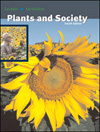 |
1 |  | 
1. Rhizomes, bulbs, and corms are all modified stems and may provide starchy staples. |
|  | A) | True |
|  | B) | False |
 |
 |
2 |  | 
2. _______ are underground horizontal stems, whereas ________are aboveground horizontal stems. |
|  | A) | a. Tubers, bulbs |
|  | B) | b. Stolons, corms |
|  | C) | c. Rhizomes, stolons |
|  | D) | d. Rhizomes, tuberous roots |
|  | E) | e. Runners, rhizomes |
 |
 |
3 |  | 
3. Although associated with Ireland, the white potato actually originated in the Andes Mountains. |
|  | A) | True |
|  | B) | False |
 |
 |
4 |  | 
4. Which factor(s) contributed to the Irish Potato Famine? |
|  | A) | a. 1695 Penal Laws |
|  | B) | b. Phytophthora infestans |
|  | C) | c. reliance on a single crop |
|  | D) | d. all of the above |
|  | E) | e. only a and b are correct |
 |
 |
5 |  | 
5. Solanum tuberosum was introduced to North America by migrating tribes of Inca Indians from what is now Bolivia. |
|  | A) | True |
|  | B) | False |
 |
 |
6 |  | 
6. The dark ring apparent on some potato chips is actually the _______ of the potato tuber. |
|  | A) | a. vascular tissue |
|  | B) | b. cortex |
|  | C) | c. pith |
|  | D) | d. bud |
|  | E) | e. starch grains |
 |
 |
7 |  | 
7. Potatoes are a good source of carbohydrates because their pith parenchyma cells are filled with starch grains. |
|  | A) | True |
|  | B) | False |
 |
 |
8 |  | 
8. Bacillus thuringiensis is a biological agent used to control _______. |
|  | A) | a. Colorado Potato Beetle |
|  | B) | b. potato blight |
|  | C) | c. potato rust |
|  | D) | d. all of the above |
|  | E) | e. none of the above |
 |
 |
9 |  | 
9. Thor Heyerdahl’s 1947 voyage from Peru to Polynesia supports the premise that the ________ was introduced to Polynesia from South America. |
|  | A) | a. yam |
|  | B) | b. white potato |
|  | C) | c. cassava |
|  | D) | d. sweet potato |
|  | E) | e. none of the above |
 |
 |
10 |  | 
10. Although most sweet potato varieties contain 50% more sugar than white potatoes, they are also an excellent source of vitamin A. |
|  | A) | True |
|  | B) | False |
 |
 |
11 |  | 
11. Cassava propagation is distinctive from other starchy staples because _______. |
|  | A) | a. starchy roots are used. |
|  | B) | b. stem cuttings are used. |
|  | C) | c. underground corm is used. |
|  | D) | d. All of the above |
|  | E) | e. None of the above |
 |
 |
12 |  | 
12. Cassava plants must be processed by boiling or frying in order to neutralize the poisonous hydrocyanic acid. |
|  | A) | True |
|  | B) | False |
 |
 |
13 |  | 
13. Although cultivation of the banana is greatest in Central America, it originated in |
|  | A) | a. South America. |
|  | B) | b. Southeast Asia. |
|  | C) | c. Central America. |
|  | D) | d. the Mediterranean. |
|  | E) | e. North America |
 |
 |
14 |  | 
14. The greatest threat to Panamanian banana plantations is Fusarium wilt that attacks the xylem cells in stem tissue. |
|  | A) | True |
|  | B) | False |
 |
 |
15 |  | 
15. Saponins, which are used to produce human hormones, are derived from |
|  | A) | a. cassava. |
|  | B) | b. white potato. |
|  | C) | c. sweet potato. |
|  | D) | d. yams. |
|  | E) | e. taro. |
 |
 |
16 |  | 
16. The starchy corm of taro contains calcium oxalate crystals and is the main ingredient in the Hawaiian dish poi. |
|  | A) | True |
|  | B) | False |
 |
 |
17 |  | 
17. The name “sunchoke” for Helianthus tuberosus refers to the plant’s arsenic compounds, which cause choking. |
|  | A) | True |
|  | B) | False |
 |
 |
18 |  | 
18. Which of the following is NOT a current use of commercially processed starch? |
|  | A) | a. glucose syrup |
|  | B) | b. sizing |
|  | C) | c. alcohol |
|  | D) | d. plastics |
|  | E) | e. coating agent for medicines |
 |



 2006 McGraw-Hill Higher Education
2006 McGraw-Hill Higher Education

 2006 McGraw-Hill Higher Education
2006 McGraw-Hill Higher Education